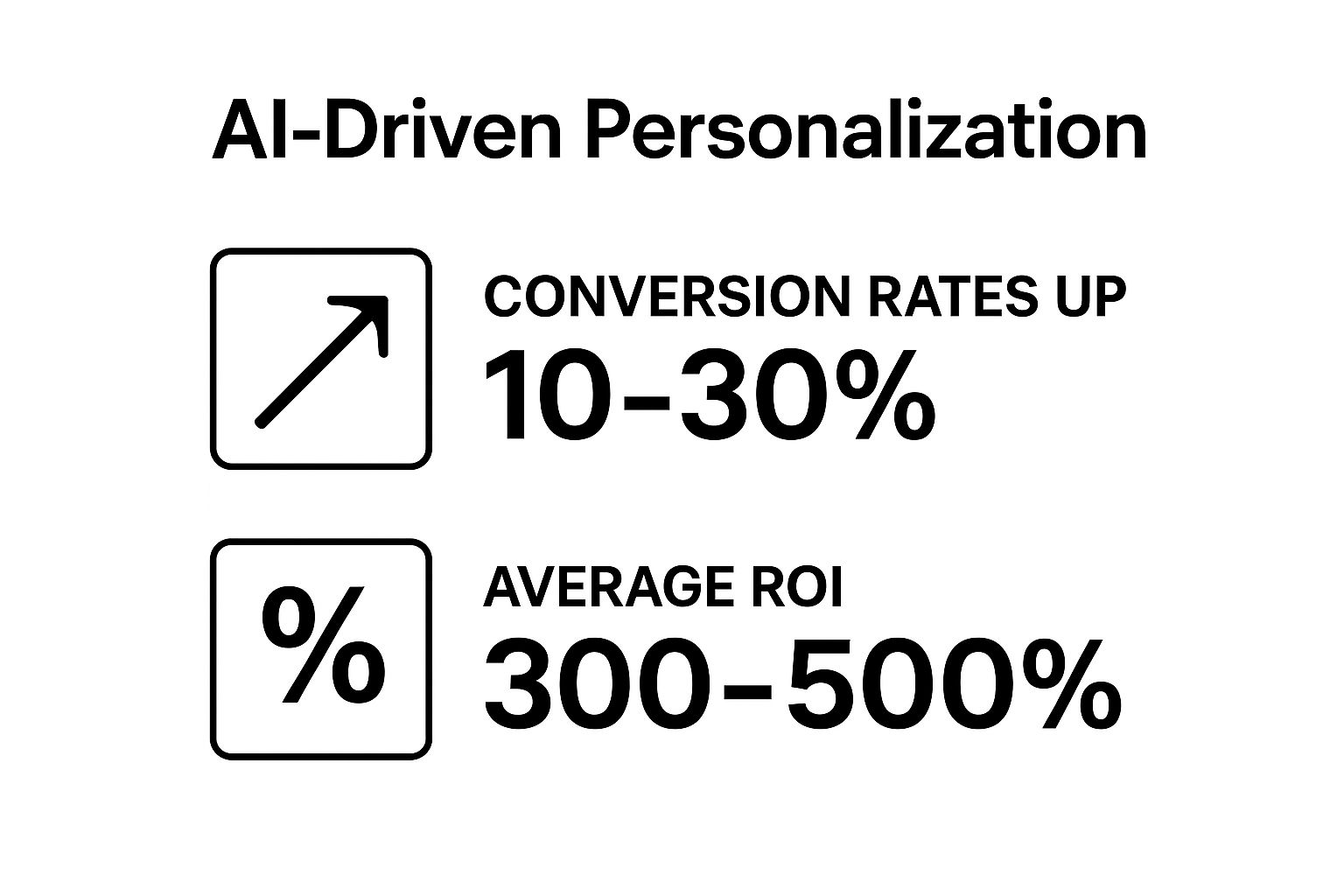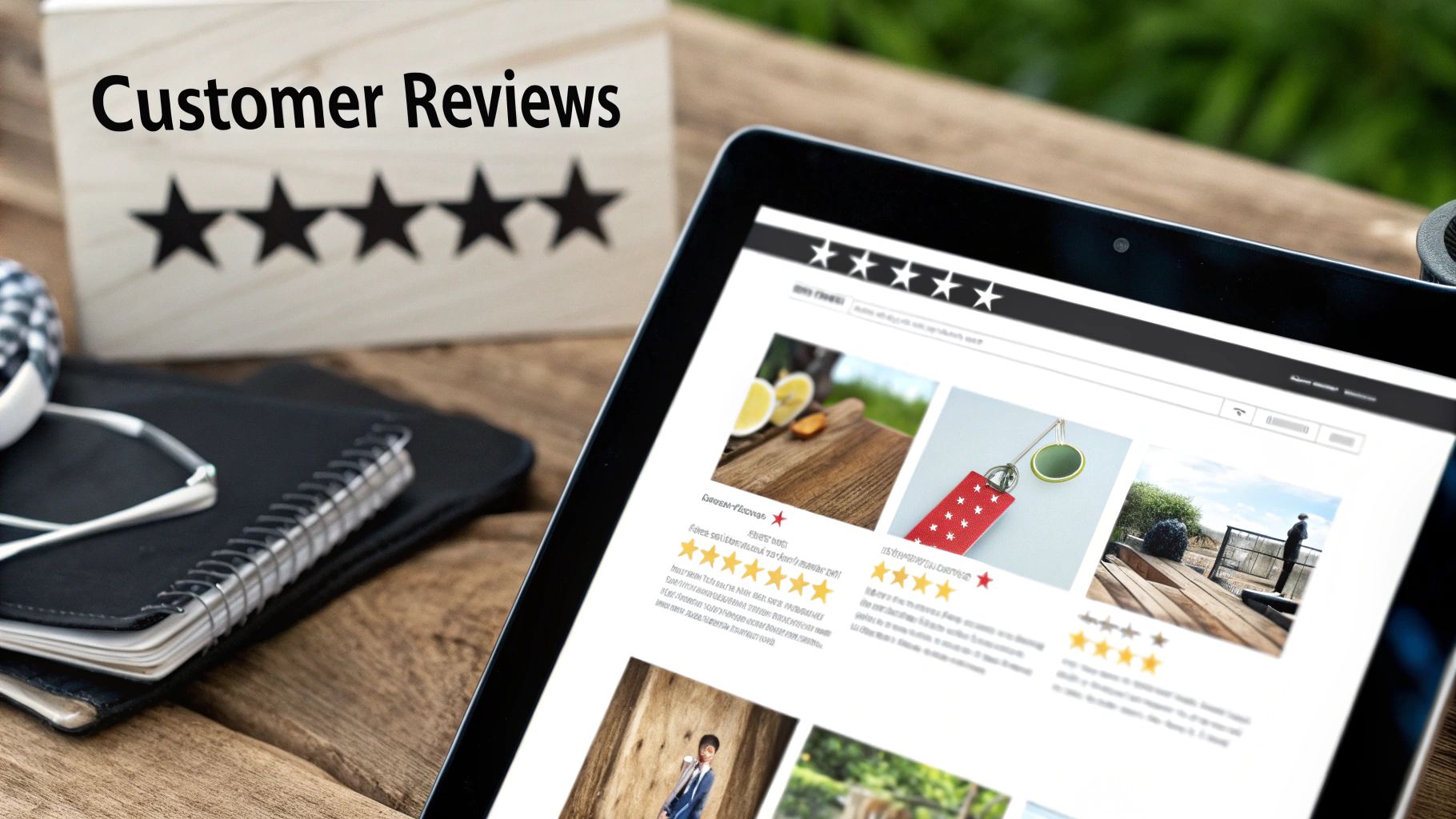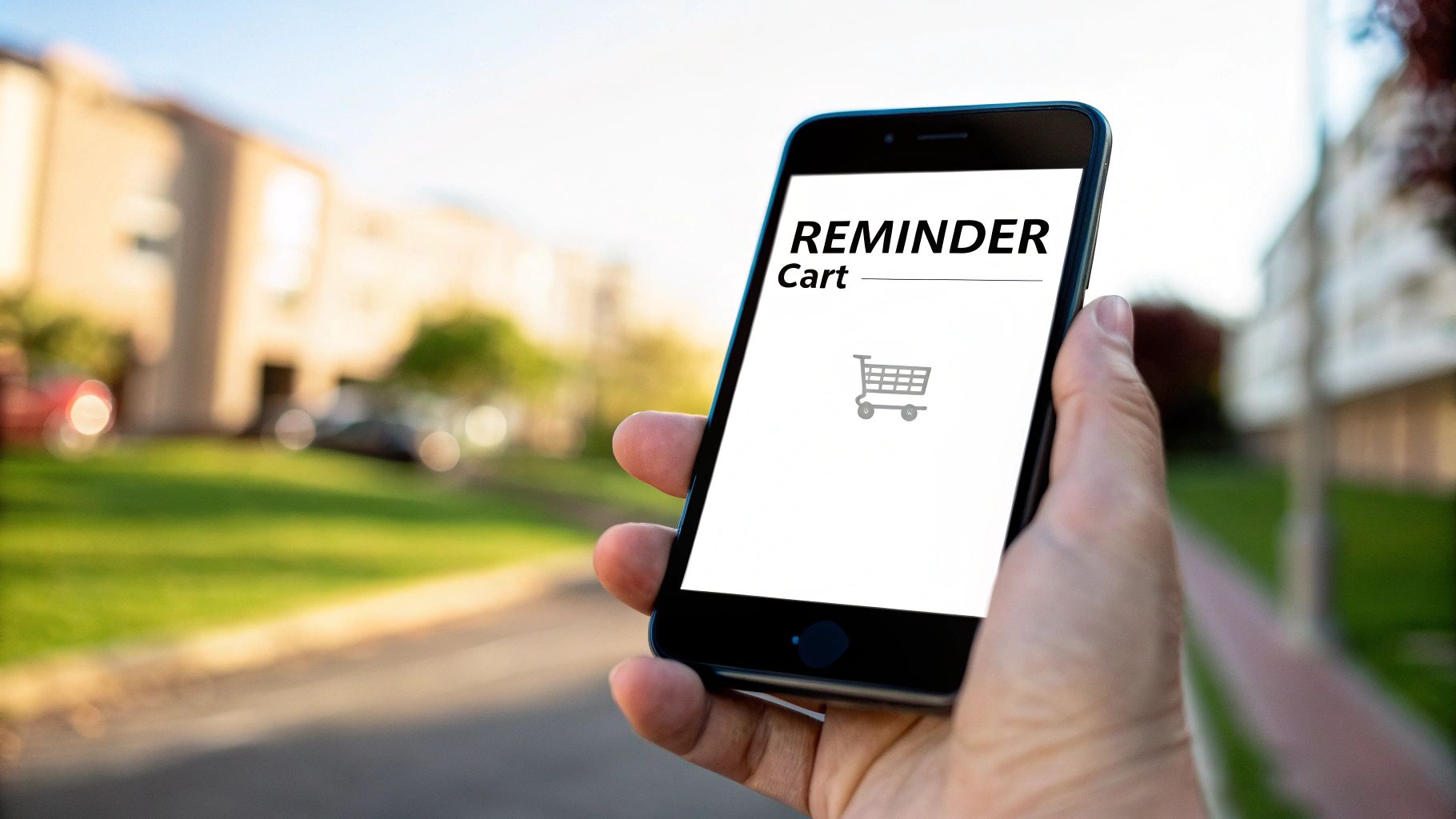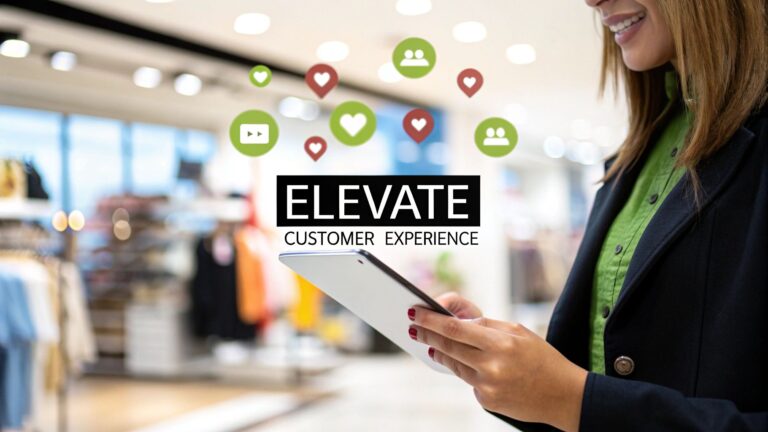In the hyper-competitive world of online retail, simply having a great product is no longer enough. The digital marketplace is crowded, and customers have more choices than ever. To not only survive but thrive, UK businesses must employ sophisticated, data-driven strategies that capture attention, build trust, and foster loyalty. Growing your online store requires more than just high-quality listings; it demands a proactive approach to engaging customers at every stage of their journey.
This guide moves beyond the basics, offering a curated roundup of nine powerful, actionable strategies designed to boost ecommerce sales. We will explore how to leverage cutting-edge AI, harness the power of social proof, and implement intelligent automation to recover lost revenue. While these tactics focus on conversion, a strong foundation is crucial. Implementing an effective ecommerce SEO strategy ensures that qualified customers can find your store in the first place, maximising the impact of every other marketing effort.
Whether you're an entrepreneur in East Anglia or an established national brand, these insights provide a clear roadmap for enhancing your online performance. Each point is backed by practical implementation steps, providing the tools you need to achieve sustainable growth and a significant return on your investment.
1. Personalisation and AI-Driven Recommendations
Moving beyond generic customer experiences is essential to boost ecommerce sales in today's crowded market. Personalisation uses artificial intelligence (AI) and machine learning to deliver bespoke product recommendations, content, and shopping journeys based on individual customer behaviour, preferences, and purchase history. This approach transforms a one-size-fits-all storefront into a unique, curated experience for every visitor, significantly increasing relevance and driving conversions.
For example, Amazon attributes as much as 35% of its revenue to its recommendation engine, while Sephora’s personalised beauty suggestions have been shown to boost conversion by 25%. These platforms analyse data points like items viewed, past purchases, and even how long a user hovers over a product to present them with items they are most likely to buy.
How to Implement AI-Driven Personalisation
Implementing this strategy effectively involves a few key steps. Start by segmenting your audience based on basic criteria like demographics or purchase history before moving to more complex AI.
- Utilise All Data: Go beyond simple purchase history. Leverage real-time browsing behaviour, abandoned cart data, and wish list items to create a holistic customer profile.
- Test and Refine: A/B test different recommendation algorithms (e.g., "Customers who bought this also bought" versus "Inspired by your browsing history") to see what resonates best with your audience.
- Deploy Across Touchpoints: Integrate personalised recommendations on your homepage, product pages, in-cart, and even in your email marketing campaigns for a consistent experience.
The following infographic highlights the direct financial impact that effective AI-driven personalisation can have on your business.

These figures demonstrate that investing in personalisation isn't just about improving the user experience; it's a proven strategy for substantial revenue growth and impressive returns. As one of the most powerful ecommerce trends, mastering personalisation is a critical step for any business looking to gain a competitive edge. To explore this topic further, you can read more about the top 5 ecommerce trends on ibertechsolutions.co.uk.
2. Social Proof and Customer Reviews
Harnessing social proof is a powerful psychological strategy to boost ecommerce sales by building trust and credibility. It involves showcasing evidence that other people have purchased and valued your products, which reduces purchase anxiety for new customers. By featuring customer testimonials, star ratings, and user-generated content, you provide impartial validation that reassures potential buyers of your product's quality and your brand's reliability.

This principle is a cornerstone of modern ecommerce. For instance, Amazon's review system is known to influence over 90% of purchase decisions, while the beauty brand Glossier built its billion-dollar valuation largely on the back of authentic user-generated content. Similarly, TripAdvisor’s vast collection of reviews is the engine that drives booking decisions for millions of travellers, demonstrating how critical peer feedback has become.
How to Implement Social Proof and Reviews
Effectively integrating social proof requires a proactive approach to gathering and displaying customer feedback. The goal is to make these trust signals a prominent and seamless part of the shopping journey.
- Actively Request Reviews: Automate post-purchase email or SMS campaigns asking satisfied customers for feedback. Make the process simple, perhaps by offering a small incentive like a discount on their next purchase.
- Display Reviews Prominently: Embed star ratings and review counts directly below product titles on both category and product pages. Feature detailed written reviews, photos, and even video testimonials further down the page.
- Respond to All Feedback: Engage with both positive and negative reviews publicly. Thanking happy customers and offering professional, constructive solutions to unhappy ones shows you are attentive and builds brand trust.
By systematically collecting and showcasing genuine customer experiences, you create a transparent and trustworthy environment. This not only validates a customer's choice but also provides them with the confidence needed to complete a purchase, directly contributing to higher conversion rates and sales growth.
3. Abandoned Cart Recovery Campaigns
One of the most effective ways to boost ecommerce sales is by recapturing revenue that is already on the brink of being lost. Abandoned cart recovery campaigns target customers who add items to their cart but leave without completing the purchase. These automated email and SMS sequences use strategic timing, personalised messaging, and incentives to re-engage these high-intent shoppers and guide them back to finalise their order, recovering otherwise lost sales.
For example, fashion giant ASOS reportedly recovers a significant portion of abandoned carts through its timely email campaigns, while homeware brand Anthropologie uses personalised product imagery to remind customers exactly what they left behind. Similarly, Nike combines email with retargeting ads for a powerful multi-channel approach, boosting its recovery rates significantly. These tactics transform a potential loss into a secured sale.

How to Implement Abandoned Cart Recovery
Setting up an effective recovery sequence is straightforward with modern ecommerce platforms and email marketing tools like Klaviyo or Omnisend. The key is a well-timed, multi-step approach.
- Act Quickly: Send the first reminder email within 1-3 hours of abandonment. This is when the purchase intent is still highest, and the message serves as a helpful reminder.
- Create a Series: Don’t stop at one email. Develop a series of 2-3 messages over several days. Vary the messaging in each one, focusing on reminders, social proof, or creating a sense of urgency.
- Use Visuals and Personalisation: Always include high-quality images of the abandoned products. Address the customer by name and reference the specific items in their cart to make the communication feel personal and relevant.
- Offer Strategic Incentives: Save incentives like a small discount or free shipping for the second or third email. Offering it too early can train customers to abandon carts deliberately.
This strategy directly targets customers who have already shown a clear interest in your products, making it one of the highest-returning marketing automations you can implement. By systematically re-engaging these shoppers, you can significantly increase your conversion rate and overall revenue with minimal ongoing effort.
4. Mobile Optimisation and Progressive Web Apps
With mobile commerce now accounting for the majority of online shopping, a seamless mobile experience is no longer optional; it's a fundamental requirement to boost ecommerce sales. Mobile optimisation involves creating a fast, intuitive, and accessible shopping journey on smaller screens, often through responsive design or Progressive Web App (PWA) technology. This strategy ensures your store performs flawlessly for every visitor, regardless of the device they use.
For instance, the AliExpress PWA led to a 104% increase in conversions for new users, and Starbucks saw its daily active users double after launching its PWA, which even works offline. These examples show that prioritising mobile isn't just about shrinking your desktop site; it's about rethinking the user journey for on-the-go customers, which directly translates into higher engagement and revenue.
How to Implement Mobile Optimisation
A mobile-first approach is key to capturing this growing market segment. Focus on speed and simplicity to create an experience that encourages purchases, not frustration.
- Prioritise Page Speed: Compress images, leverage browser caching, and minimise code to ensure your mobile pages load in under three seconds.
- Simplify the Checkout: Reduce the number of form fields, offer guest checkout, and integrate mobile-friendly payment options like Apple Pay and Google Pay.
- Design for Touch: Use large, clear buttons and leave ample space between clickable elements to prevent accidental taps and improve usability.
Investing in a high-quality mobile experience is one of the most reliable ways to improve conversion rates. For a deeper dive, you can learn more about the key ecommerce website design tips on ibertechsolutions.co.uk.
The following video from Google explains the core concepts and benefits of Progressive Web Apps in more detail.
By embracing mobile-first design and PWA technology, you can create a superior shopping experience that captures sales from the ever-growing number of mobile shoppers.
5. Email Marketing Automation and Segmentation
Email remains one of the most effective channels to boost ecommerce sales, but batch-and-blast campaigns no longer suffice. Strategic email marketing automation involves sending targeted messages that trigger automatically based on specific customer behaviours, preferences, and lifecycle stages. By segmenting your audience and tailoring your communications, you ensure each message is highly relevant, building stronger customer relationships and driving repeat purchases.
For instance, Dollar Shave Club’s engaging welcome series reportedly drives 25% of its new customer revenue. Similarly, Birchbox achieves impressive 40% open rates with its personalised product emails, and Patagonia’s values-driven campaigns see a 30% higher click-through rate. These brands demonstrate the power of sending the right message to the right person at the right time.
How to Implement Email Automation and Segmentation
Getting started with this powerful strategy requires organising your audience and creating thoughtful automated workflows. Focus on delivering value with every send.
- Segment Your Lists: Group subscribers based on purchase history (e.g., first-time buyers, VIPs), browsing behaviour (e.g., viewed a specific category), and engagement levels (e.g., active vs. inactive).
- Create Triggered Campaigns: Develop automated series for key actions like welcome emails for new subscribers, abandoned cart reminders, and re-engagement campaigns for customers who haven't purchased in a while.
- Optimise for Engagement: Use compelling subject lines, include clear call-to-action buttons, and test different send times to discover what works best for your audience. Regularly clean your lists to maintain high deliverability rates.
Investing in a robust email strategy provides a direct line to your customers, nurturing them from initial interest to loyal advocates. It is a proven, high-ROI method for sustained growth. To get the most out of your campaigns, you can explore some email marketing best practices on ibertechsolutions.co.uk.
6. Influencer Marketing and User-Generated Content
Harnessing the power of social proof is a proven way to boost ecommerce sales, and influencer marketing is a direct route to achieve this. This strategy involves partnering with social media creators who have built a loyal following. By leveraging their credibility and reach, brands can introduce their products to engaged audiences in an authentic, trust-building way. This is often combined with encouraging user-generated content (UGC), where customers share their own experiences, creating a powerful cycle of social proof.
For instance, watch brand Daniel Wellington famously built a $200 million empire almost entirely through influencer collaborations. Similarly, fitness apparel giant Gymshark leveraged partnerships with prominent fitness influencers to achieve a valuation of over $500 million, turning creators into genuine brand ambassadors. This approach taps into established communities, driving both brand awareness and direct sales.
How to Implement Influencer and UGC Strategies
To implement this effectively, focus on authenticity and building genuine relationships rather than just transactional exchanges.
- Focus on Engagement: Look for influencers whose audience is highly engaged, not just those with the largest follower counts. High engagement rates often translate to higher conversion rates.
- Ensure Brand Alignment: Choose creators whose values, aesthetic, and audience align with your brand. An authentic partnership will resonate far more effectively than a mismatched one.
- Track Performance: Provide influencers with unique discount codes or affiliate links. This allows you to accurately measure the ROI of each campaign and identify your most effective partners.
- Encourage and Repurpose UGC: Run contests, create branded hashtags, and feature customer photos on your product pages and social media feeds to incentivise content creation and build a community around your products.
To truly leverage this strategy, it's crucial to understand why influencer marketing works and how it builds consumer trust. Mastering this allows you to move beyond one-off campaigns towards building long-term, mutually beneficial relationships that consistently drive revenue and strengthen your brand's reputation in a crowded marketplace.
7. Retargeting and Remarketing Campaigns
Not every visitor will convert on their first visit, but that doesn't mean the opportunity is lost. Retargeting campaigns are a powerful way to re-engage potential customers who have previously visited your website but left without making a purchase. By using tracking pixels to identify these visitors, you can serve them targeted ads on other platforms like social media and search engines, reminding them of your products and guiding them back to your store. This strategy is essential to boost ecommerce sales by capitalising on existing, high-intent traffic.
For instance, furniture giant Wayfair uses Facebook’s dynamic product ads to recover an estimated 15% of its abandoned sessions by showing users the exact items they viewed. Similarly, Criteo, a leader in the field, serves over 700 billion personalised ads monthly, reconnecting brands with shoppers who have shown clear interest. These examples prove that a well-executed retargeting strategy keeps your brand top-of-mind and effectively bridges the gap between initial interest and final purchase.
How to Implement Retargeting Campaigns
Getting started with retargeting requires a strategic, segmented approach to avoid annoying potential customers and maximise your return on ad spend (ROAS).
- Segment Your Audience: Don't treat all visitors the same. Create separate audiences based on specific actions, such as viewing a product page, adding an item to the cart, or visiting the checkout page. This allows for highly relevant messaging.
- Use Dynamic Ads: Instead of generic brand ads, use dynamic ads that automatically showcase the specific products a user viewed or added to their cart. This personalised approach is far more compelling.
- Set Frequency Caps: To prevent ad fatigue, limit the number of times a single user sees your ad within a specific period. Bombarding users can do more harm than good.
- Exclude Recent Buyers: Ensure you have a system in place to automatically remove customers from your retargeting campaigns as soon as they make a purchase. Showing ads for a product they just bought creates a poor experience.
8. Live Chat and AI Chatbots for Customer Support
Providing instant, real-time support is a powerful way to boost ecommerce sales by removing friction at critical moments in the customer journey. Live chat and AI chatbots offer immediate assistance, answering product questions, clarifying shipping policies, and guiding users towards a purchase. This combination of human agents and automated support resolves issues before they lead to cart abandonment, building trust and improving the overall shopping experience.
For example, 1-800-Flowers found that its chatbot successfully processes over 70% of customer inquiries, freeing up human agents for more complex issues. Similarly, H&M's Kik chatbot achieved an impressive 87% user satisfaction rate by offering style advice and directing users to products. These tools turn a passive browsing session into an interactive, supportive dialogue that directly addresses customer needs and hesitations.
How to Implement Live Chat and Chatbots
Integrating this strategy effectively requires a balanced approach between automation and human oversight. Begin by identifying the most common customer questions to automate first.
- Automate Common FAQs: Use a chatbot to handle frequent, simple queries like "What is your return policy?" or "Where is my order?". This provides instant answers and reduces the load on your support team.
- Provide Clear Escalation: Ensure customers can easily connect with a human agent if the chatbot cannot resolve their issue. A frustrating bot experience is worse than no chat at all.
- Use Proactive Triggers: Set up chat invitations to appear based on user behaviour, such as lingering on a product page for a long time or visiting the checkout multiple times. This proactive engagement can pre-empt questions and guide uncertain shoppers.
- Train and Refine: Continuously analyse chat transcripts to identify areas where the chatbot struggles. Use this data to train the AI, refine its responses, and improve its effectiveness over time.
9. Subscription and Loyalty Programmes
Shifting focus from one-off transactions to long-term customer relationships is a powerful way to boost ecommerce sales and create a stable, predictable revenue stream. Subscription models and loyalty programmes incentivise repeat business by offering exclusive benefits, rewards, and a sense of community. This strategy transforms customers into brand advocates, significantly increasing customer lifetime value (CLV) and fostering brand allegiance.
For instance, Amazon Prime’s combination of shipping benefits and exclusive content has attracted over 200 million members globally, while the Starbucks Rewards programme is responsible for driving around 40% of the company's total revenue. Similarly, Dollar Shave Club built its entire business on a convenient subscription model, proving that recurring revenue models can be immensely successful.
How to Implement Subscription and Loyalty Programmes
Building an effective programme requires a clear value proposition and seamless user experience. Start by defining what makes your programme compelling and easy for customers to join and use.
- Offer Tangible and Experiential Rewards: Combine transactional benefits like discounts or points with experiential rewards such as early access to new products, exclusive content, or invitations to special events. This caters to different customer motivations.
- Simplify Enrolment: Make the sign-up process as frictionless as possible. Offer immediate value upon joining, such as a welcome discount, to encourage instant participation.
- Communicate Value Consistently: Regularly remind members of their benefits and progress through personalised emails and account dashboards. Show them the savings they have accumulated or the rewards they are close to unlocking.
- Analyse Member Behaviour: Use data from your programme to understand what your most loyal customers purchase and what rewards they value most. Use these insights to refine your offerings and further personalise the experience.
9 Strategies to Boost Ecommerce Sales Comparison
| Strategy | Implementation Complexity 🔄 | Resource Requirements ⚡ | Expected Outcomes 📊 | Ideal Use Cases 💡 | Key Advantages ⭐ |
|---|---|---|---|---|---|
| Personalization and AI-Driven Recommendations | High 🔄🔄🔄 | High ⚡⚡⚡ | Conversion +10-30%, ROI 300-500% 📊 | Businesses with rich customer data | Boosts engagement, avg. order value, loyalty ⭐ |
| Social Proof and Customer Reviews | Low to Moderate 🔄 | Low ⚡ | Conversion +18-34%, trust 88% 📊 | Trust building, new products, social validation | Builds credibility quickly, low cost ⭐ |
| Abandoned Cart Recovery Campaigns | Moderate 🔄🔄 | Moderate ⚡⚡ | Recovers 10-15% carts, high ROI 📊 | E-commerce checkout abandonment | Automated recovery, targets qualified leads ⭐ |
| Mobile Optimization and Progressive Web Apps | High 🔄🔄🔄 | High ⚡⚡⚡ | Mobile conversions up to +200%, reduced bounce 📊 | Mobile-first commerce, increasing mobile traffic | Improves user experience, SEO, cost-effective ⭐ |
| Email Marketing Automation and Segmentation | Moderate 🔄🔄 | Moderate ⚡⚡ | Highest Marketing ROI (42:1) 📊 | Customer retention, repeat purchases | Highly measurable, cost-effective ⭐ |
| Influencer Marketing and User-Generated Content | Moderate 🔄🔄 | Moderate ⚡⚡ | ROI $5.78 per $1 spent, large market size 📊 | Brand awareness, social engagement | Authentic content, targeted reach ⭐ |
| Retargeting and Remarketing Campaigns | Moderate to High 🔄🔄🔄 | Moderate ⚡⚡ | Conversion 3-5x higher than cold traffic 📊 | Visitors who left without purchasing | Targets warm leads, cost-effective ⭐ |
| Live Chat and AI Chatbots for Customer Support | Moderate to High 🔄🔄🔄 | Moderate to High ⚡⚡⚡ | Conversion +40%, 85% customer preference 📊 | Real-time support, FAQs, lead capture | Instant assistance, reduced support costs ⭐ |
| Subscription and Loyalty Programs | High 🔄🔄🔄 | High ⚡⚡⚡ | Lifetime value +25-100%, retention up 5x 📊 | Repeat purchase businesses, brand loyalty | Predictable revenue, competitive edge ⭐ |
From Strategy to Sales: Implementing Your Growth Engine
Navigating the competitive digital marketplace requires more than just a functional website; it demands a strategic, multi-layered approach to customer engagement and conversion. The journey to effectively boost ecommerce sales isn't about finding a single, elusive solution. Instead, it's about methodically building a powerful, interconnected growth engine fuelled by the strategies we've explored throughout this guide.
Each tactic, from the sophisticated personalisation offered by AI-driven recommendations to the foundational trust built through authentic customer reviews, plays a distinct yet complementary role. Abandoned cart recovery campaigns act as your safety net, reclaiming lost revenue, while a flawlessly optimised mobile experience ensures you meet customers wherever they are. These are not isolated fixes but integral cogs in a larger machine designed for sustainable growth.
Turning Insights into Actionable Growth
The most critical takeaway is the imperative to act. Reading about these strategies is the first step, but implementation is what separates aspiration from achievement. Resisting the urge to tackle everything at once is key. A more effective approach involves a focused, iterative process:
- Audit and Prioritise: Begin by conducting a candid assessment of your current ecommerce performance. Identify your biggest bottleneck. Is it attracting new visitors, converting them into customers, or retaining their long-term loyalty? Select the one or two strategies from our list that most directly address your most pressing challenge.
- Implement with Precision: Dedicate your resources to implementing your chosen strategies correctly. Whether it's setting up segmented email automation, launching your first influencer collaboration, or integrating a live chat function, focus on a high-quality execution.
- Measure and Refine: The digital landscape provides a wealth of data. Meticulously track key performance indicators (KPIs) relevant to your new initiative. Analyse the results, gather customer feedback, and use these insights to continuously refine your approach. This cycle of implementation, measurement, and optimisation is the heartbeat of a successful ecommerce business.
The Power of an Integrated System
True momentum is achieved when these elements work in harmony. For instance, insights from your AI chatbot can inform the content of your email marketing, while user-generated content from a successful social campaign provides powerful social proof for your product pages. To achieve a truly integrated approach across your sales funnel, consider how to leverage advanced personalized marketing automation strategies. By connecting these dots, you create a seamless customer journey that not only boosts immediate sales but also cultivates lasting brand loyalty and advocacy. Ultimately, mastering these concepts is what transforms a simple online shop into a dynamic and resilient ecommerce powerhouse.
Ready to transform these strategies into tangible revenue for your business? The expert team at Ibertech Solutions Limited specialises in creating bespoke ecommerce websites and implementing targeted digital marketing campaigns for businesses across East Anglia. Let us help you build the powerful growth engine your brand deserves.





